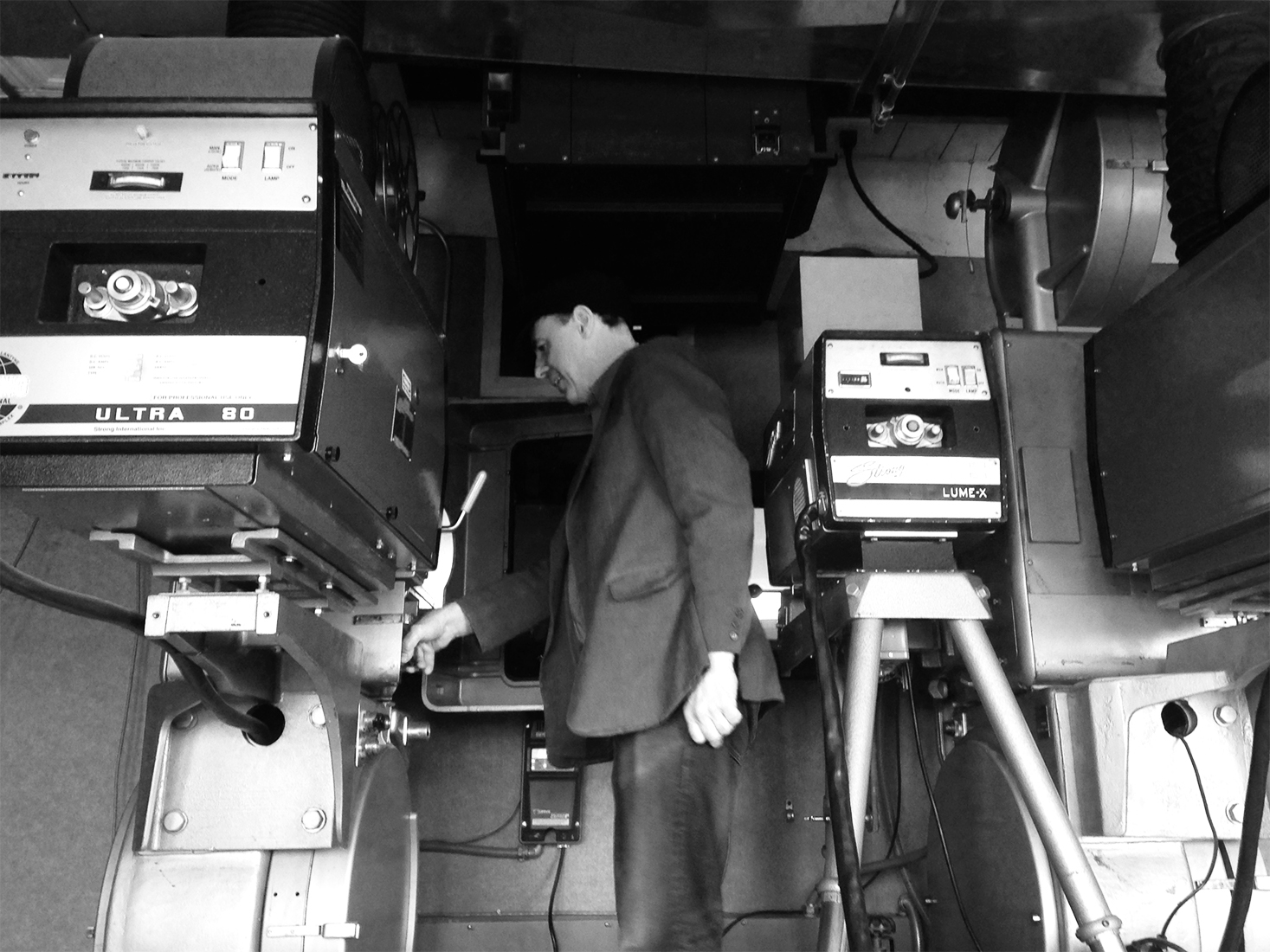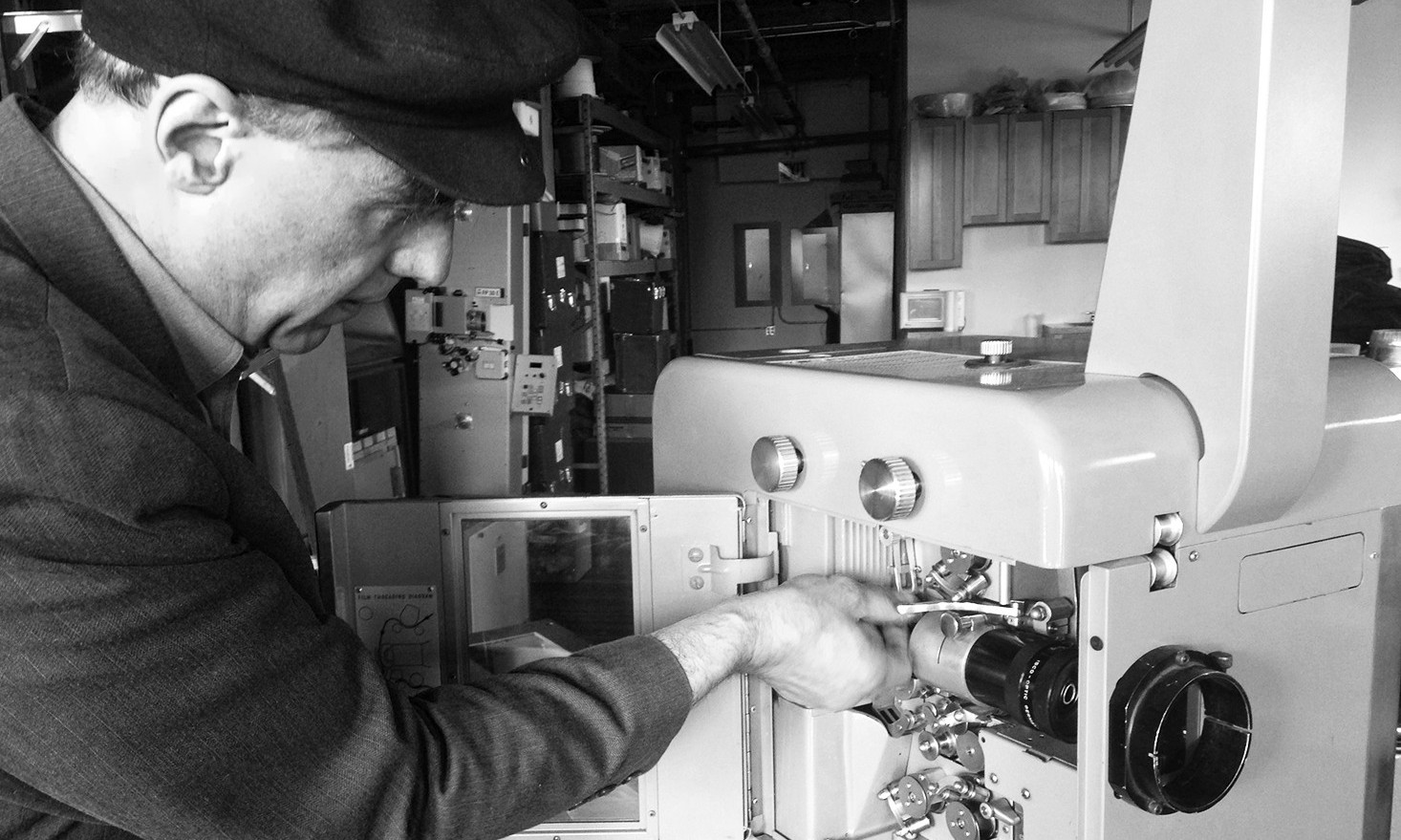James Bond has no problem showing films that, possibly, in the right conditions, could explode.
“I don’t like doing this,” he says, “but I have to show you what I did last Thursday. This is a format called nitrate film.”
The projectionist takes out a Kodak cheat sheet that looks like a map from National Treasure — a listing of shapes and symbols that indicate when a film was made. Bond’s nitrate filmstrip, flammable if snagged in the projector, was old enough that it showed veterans marching in a Michigan Avenue parade dressed for the Civil War. According to his key, the year was 1918.
“And yet the image was stunning,” Bond says. “No scratches, no jitter, no weaves — beautiful takes, in which they were showcasing the gorgeous nature of 35 mm film 97 years earlier.”
He showed the film last week to a group of film archivists like him, who gather every Thursday night to watch old films in his 52-capacity private theater in Wicker Park, Chicago. The theater is in an old, unmarked building heated by a wood-burning stove. It was a sweatshop before Bond rented it out in 1983. He arranged 52 puffy blue lounge chairs. Refurbished a 1930s sound amplifier and 1940s speakers. And installed two ’60s-era projectors in the back room. Bond shows them off like a guy at a Sunday car show. “I’ve maintained and modified the hell out of them,” he says.
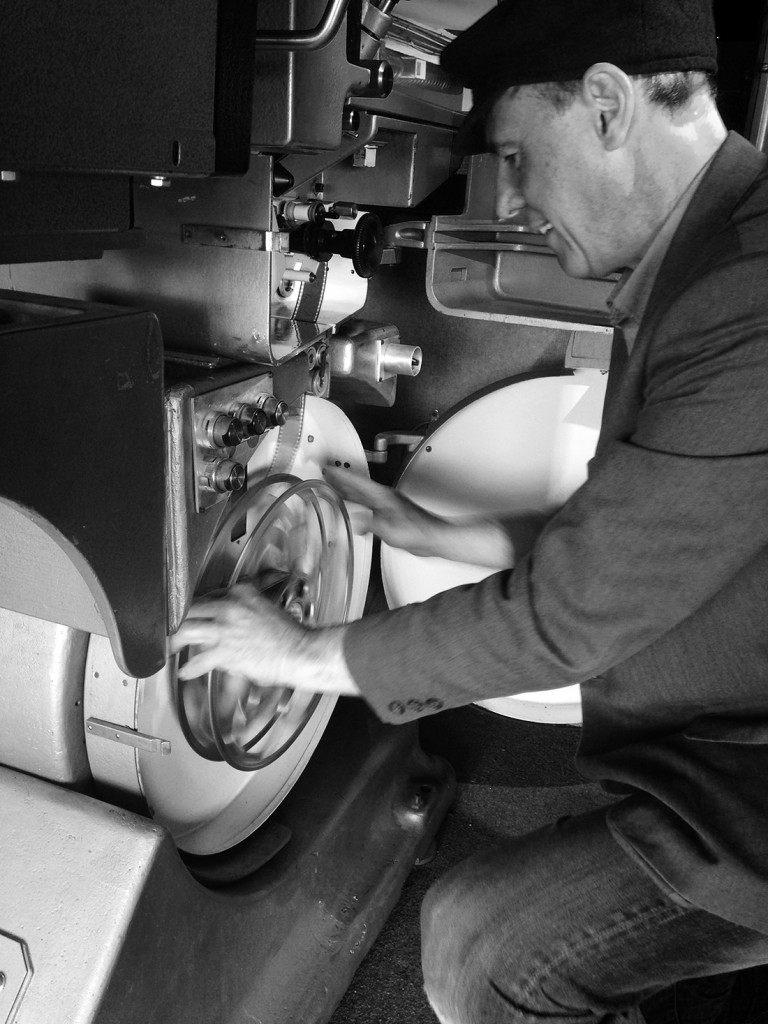
It’s nothing new for Bond. At 54, he’s spent two-thirds of his life, 36 years, tooling with bulbs and mirrors in order to create the perfect movie-going experience. All for people who, if Bond does his job right, will never know he’s there. See, Bond doesn’t just project movies — he builds their vessels. The projectors themselves. He thinks about phenomena like optical physics, retinal perception speed, and “chromatic polarization” — aka 3-D projection — and says sorry too much when he attempts to explain what any of it means. His attention to detail is why you never notice the glaring EXIT sign near the front of the theater.
And it’s also built him a reputation. Bond has been contracted to design projectors for everyone from a Houston film museum to a Kazakhstan film festival. Since 1999, he’s been the head projectionist at Roger Ebert’s Film Festival. And when Ebert was alive, the famed film critic himself would often call Bond one of the best projectionists in the world. “He’s legendary,” says Antonella Bonfanti, a film preservationist and collection manager at San Francisco’s Canyon Cinema. “In terms of the support he’s provided to the community, in terms of his standards, his expertise — he’s pretty much top-notch. As good as they come.”
But James Bond is also very rare — fancy recognition aside. His expertise in designing today’s top-notch digital projectors is grounded in decades of fascination with its analog counterpart. Which is a bit of an oxymoron: The digital machines Bond must design today, in order to stay relevant, are the very things that have sent projectionists to the wayside. Today’s digital projectors require little more than pushing a button. James Bond knows an 11-month-old baby who has done it. As a result, theater management would rather send the candy counter guy up to the booth than put a trained projectionist on payroll.
It’s caused Bond and many other 20th century projectionists to ask: If the future eliminates projection as a skilled and careful labor, then who will show a nitrate film in 50 years?
When it began taking over in 2007, the digital projector stole a little bit of magic from cinema.
For centuries, the concept of moving images was nearly supernatural. Before film, in the 1800s, there were little illusion toys with funny names — Zoetropes, Praxinoscopes, Kinetoscopes — all of which used mirrors and rotating pictures to fool the mind into seeing movement. And before illusion toys were magic lanterns, the projector’s earliest ancestor: little boxes that looked like stoves with a long-necked lens protruding from the front. Illusionists had been using them in their magic shows since the 17th century, manipulating still images to project them into motion — even sometimes creating the illusion of ghastly demons to scare their audience.
But even hundreds of years after the fact, film projection as magic isn’t such a figurative idea — at least for the man in the booth. “I think you see a lot of people being taken in by the transformative aspects of projection for a large group,” Bond says. “It kind of gives you a false sense of authority, because you’re the guy in charge — you’re the magician pulling the tricks. You are actually creating images from nothing for a captive audience.”
Figuring out how was the question that pulled Bond to projection as a young adult. “Curiosity was my teacher,” he says. He was 19 the first time he took apart a 1920s projector and refurbished it in his parents’ garage. He learned how the thousands of little pictures on a filmstrip could move through a shutter so fast — 24 frames a second — that your eyes would never catch them in transit. How what you see on the screen is the result of one strong light bulb and one curved mirror, working in tandem to project one fluid, overwhelming moving picture.
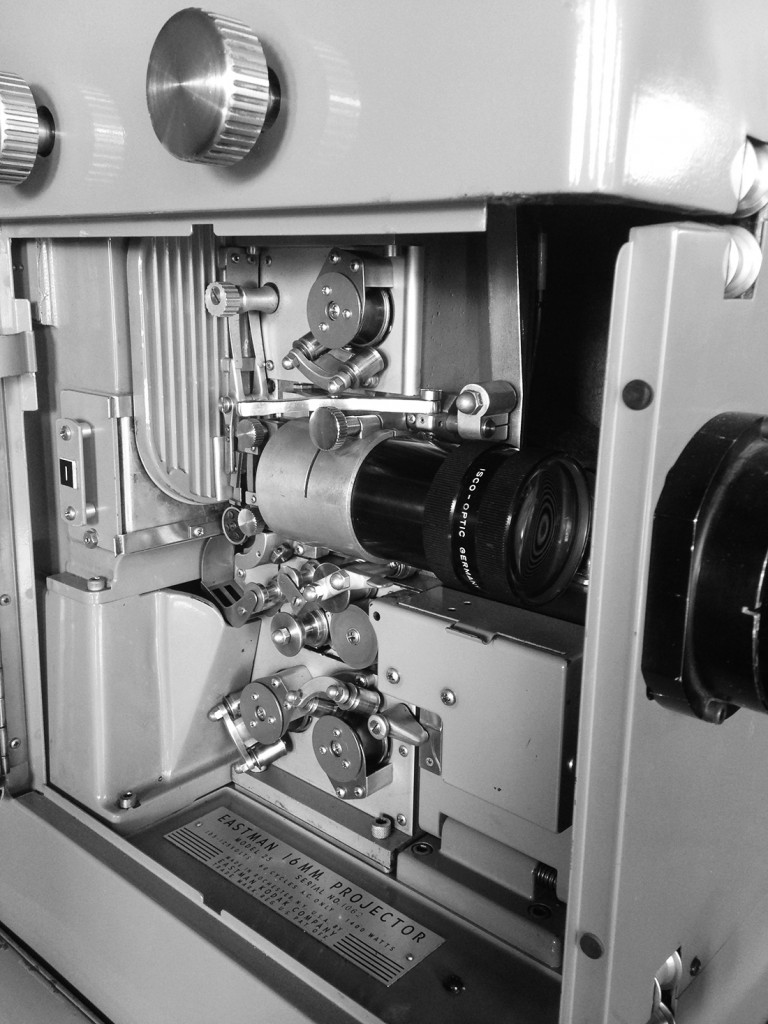
The projectionist comes in when he or she has to change the reels every 20 minutes. Seamlessly, so that you never notice anything changed. It’s why there are two film projectors and two windows in every film booth. The projectionist also inspects the filmstrips and repairs them before every show. They’re like caretakers more than anything, of both the physical film and the moviegoer’s experience, too.
The digital projector today eliminates all of the above.
According to the London-based IHS Cinema Intelligence, nearly 90 percent of the world’s cinema screens have made the switch from film to digital — mostly in the past six years. The rest are small art house theaters that can’t afford the $70,000 cost per screen to convert.
This across-the-board changeover isn’t a matter of quality. Digital is simply cheaper. Distributors don’t have to pay $2,000 per film print to physically ship it to hundreds of theaters. And theater management saves thousands when they don’t need to pay for the labor. By 2022, the Bureau of Labor Statistics estimates projectionist employment will have fallen 26 percent, from 8,000 to 5,920.
Noting this steep decline, Bonfanti says the digital takeover is making it hard to teach aspiring film projectionists the skills. They won’t be able to stroll into their local theater for an apprenticeship if there’s no film projector in house. It’s why Bonfanti and the Association of Moving Image Archivists set up a film projection workshop in Austin. They wanted to provide the opportunity for young projectionists that’s otherwise lacking.
“It was something we felt was an important thing to do at this time,” Bonfanti says, “because with the increase of digital projection in multiplexes, it means that there’s kind of an atrophy of skills with regard to film projection. While there’s still a lot of trained projectionists out there, it’s a big moment to pass on the knowledge before it’s so far down the line that the expertise goes away.”
The future of projection lives in an apartment on the South Side of Chicago.
The apartment is home to a bona fide movie theater and film archive. A 35 mm projector rests on top of a booth three feet from the front door. A screen pulls down in the living room, covering all the windows. And four long couches and a few lounge chairs serve as comfier, homier versions of theater seating.
The projectionists running the show are 23-year-old Julian Antos and 28-year-old Rebecca Hall, two co-founders of the Northwest Chicago Film Society. And James Bond is their mentor. Last week, it was Antos who projected the dangerous nitrate film in Bond’s private theater — something Bond is confident very few his age could do. “He’s a young version of myself,” Bond says. “He took the baton and continued as the next leg in the sprint. He’ll do it. And other young people will hopefully recognize that.”
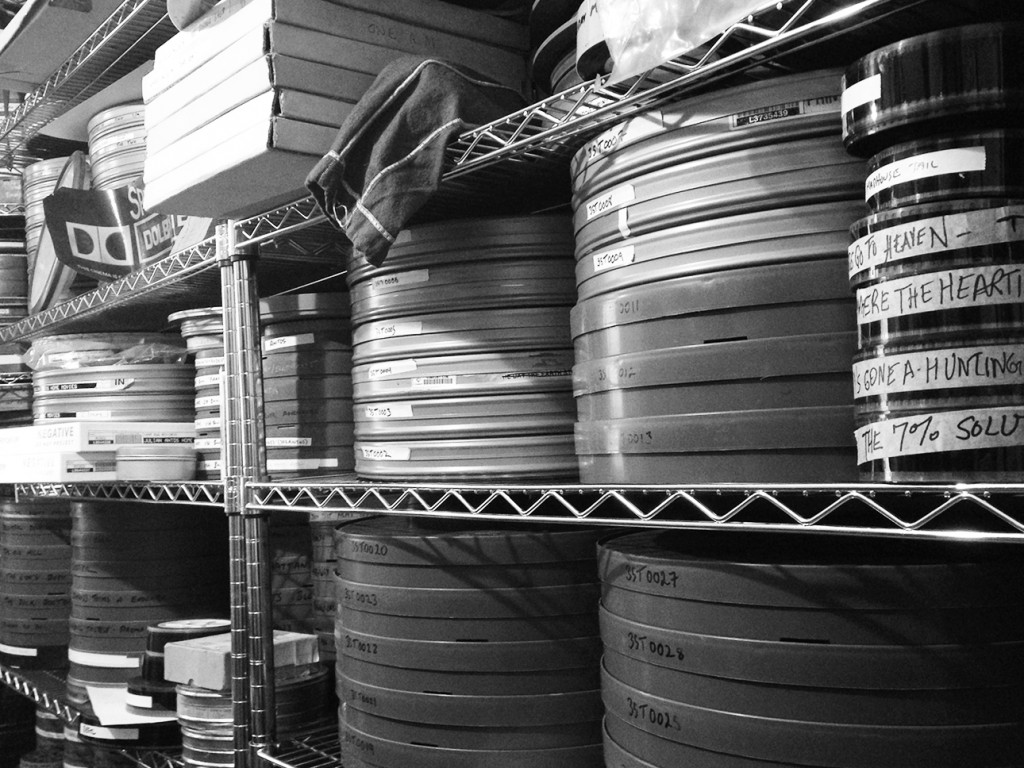
Along with Kyle Westphal, Hall and Antos founded the Film Society with the goal of not only preserving film, but also preserving the way we experience it. They aren’t trying to “save” film — to Hall, that implies it’s going to die. But they do want to make sure it won’t become so obscure that you only find it in museums. It’s why they’re showing films in their living room — to make it more accessible. At their house, movie nights mean inviting 70 people over.
“We are cultural custodians,” Antos says. “We’re responsible for taking care of this very specific sector of moving image art that maybe some people… not don’t care about, but don’t think about. So we’re in charge of caring about it and thinking about it, making sure it stays around.”
With every year, it’s getting harder. Paramount Pictures announced in January 2014 that it would discontinue distributing any movie on film. Its last film was Anchorman 2 — until Christopher Nolan convinced Paramount to make an exception for Interstellar. Kodak announced in July 2014 that it would stop manufacturing film, having experienced a 96 percent decline in film sales since 2006. But then cranky old-school directors — including Nolan, Quentin Tarantino, and J.J. Abrams — rallied for a reprieve. They promised to continue shooting their flicks on film. Like Abrams has with Star Wars: Episode VII – The Force Awakens.
Still, it will be shown digitally. Most take no issue with digital projectors, including Hall and Antos. In fact, Hall says that both film and digital have their own sets of strengths, and so comparing their levels of quality is a moot argument. One difference: Hall doesn’t see people pressing their noses to the glass to watch the magic of digital at work, mostly because there’s just not that much magic. “There’s nothing really that interesting about a box with light coming out of it,” she says. “You can’t see anything about how it works.”
To document the magic of film on paper, Hall and Antos started an initiative called Projectionists Draw Projectors. The initiative aims to record how projectionists relate to their machines and to show “a sense of the skill and affection involved in every level of the trade.” Because all too often, the problem with film as magic is that it’s too easy to forget the magician.
“The magic of cinema sort of works against itself, because you’re not supposed to think about what is making the image on the screen,” Hall says. “Projectionists are always told that a good projectionist is a projectionist who no one knows is there. But having that level of opacity makes it more difficult to think of film in the context that most people think about art and sculpture. Because you’re not supposed to think about the mechanism. The mechanism is just this magic thing that’s happening on the screen, and you’re not even supposed to think about where it’s coming from.
“That’s also part of the core of the work that we’re doing — we want that to change.”
The walk back from Bond’s private theater to his loft-like office is a brisk one.
Bond is in no hurry to work, but he does have special gadgets — glorified illusion toys — waiting for him when he returns. All are necessary tools he’ll need to put on a show at the looming, sold-out Ebertfest. There’s the 1,400 special 3-D glasses stacked outside his door — not the cheap kind you throw away, Bond clarifies — and the special 4,500-watt xenon bulb that will power the digital 3-D images to life. This will be the first time a 3-D movie has ever been shown at the host 1920s theater. “We’re stacking hundreds of technical evolutions on top of each other,” Bond says.
But still, as he climbs down the uneven three flights of stairs of his theater, he fixates on the 97-year-old nitrate film. Because that’s where those hundreds of technical evolutions began. “If you’re asking about the future of projection in terms of the ability to project nitrate 97 years from now,” Bond says, “it’s very low, because people like me will be so rare that we’ll only be at museums like the ones I service now — the Art Institute, Harvard’s Film Archive. Little guys like me and Julian Antos, they’ll be gone.”
But Bond has other ways to make sure that film, at least, won’t be.
For every new projection booth he designs, he still makes sure there’s room for two projectors. He’s thinking about the projectionists 50 years from now: How else will they change the reels on a 147-year-old film?
